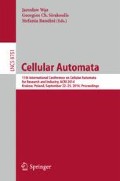Abstract
One room with one exit and one multiple entrance is modelled using 32 different settings and modifications of floor field model. The influence of following aspects are investigated in the scope of the transition from free flow to congestion phase with respect to the inflow rate: Heterogeneity/Homogeneity; With/Without bounds; Moore/von Neumann neighbourhood; Synchronous/Asynchronous update; High/Low friction. Considering the average travel time through the room and average room occupancy the settings incorporating the bounds and synchronous update seems to match the experimental data from the qualitative point of view.
Access this chapter
Tax calculation will be finalised at checkout
Purchases are for personal use only
Preview
Unable to display preview. Download preview PDF.
References
Bukáček, M., Hrabák, P., Krbálek, M.: Cellular model of pedestrian dynamics with adaptive time span. In: Wyrzykowski, R., Dongarra, J., Karczewski, K., Waśniewski, J. (eds.) PPAM 2013, Part II. LNCS, vol. 8385, pp. 669–678. Springer, Heidelberg (2014)
Bukáček, M., Hrabák, P., Krbálek, M.: Experimental analysis of two-dimensional pedestrian flow in front of the bottleneck. In: Traffic and Granular Flow 2013. Springer, Heidelberg (to be published, 2014)
Cornforth, D., Green, D.G., Newth, D.: Ordered asynchronous processes in multi-agent systems. Physica D 204(1-2), 70–82 (2005)
Ezaki, T., Yanagisawa, D., Nishinari, K.: Analysis on a single segment of evacuation network. Journal of Cellular Automata 8(5-6), 347–359 (2013)
Ezaki, T., Yanagisawa, D., Ohtsuka, K., Nishinari, K.: Simulation of space acquisition process of pedestrians using proxemic floor field model. Physica A 391(1-2), 291–299 (2012)
Hrabák, P., Bukáček, M., Krbálek, M.: Cellular model of room evacuation based on occupancy and movement prediction: Comparison with experimental study. Journal of Cellular Automata 8(5-6), 383–393 (2013)
Kirchner, A., Nishinari, K., Schadschneider, A.: Friction effects and clogging in a cellular automaton model for pedestrian dynamics. Physical Review E 67(5 2), 056122/1–056122/10 (2003)
Kirchner, A., Schadschneider, A.: Simulation of evacuation processes using a bionics-inspired cellular automaton model for pedestrian dynamics. Physica A: Statistical Mechanics and its Applications 312(1-2), 260–276 (2002)
Nishinari, K., Kirchner, A., Namazi, A., Schadschneider, A.: Simulations of evacuation by an extended floor field ca model. In: Hoogendoorn, S., Luding, S., Bovy, P., Schreckenberg, M., Wolf, D. (eds.) Traffic and Granular Flow 2003, pp. 405–410. Springer, Heidelberg (2005)
Schadschneider, A., Chowdhury, D., Nishinari, K.: Stochastic Transport in Complex Systems: From Molecules to Vehicles. Elsevier Science B. V., Amsterdam (2010)
Schadschneider, A., Seyfried, A.: Empirical results for pedestrian dynamics and their implications for cellular automata models. In: Timmermans, H. (ed.) Pedestrian Behavior - Models, Data Collection and Applications, pp. 27–43. Emerald Group, Bingley (2009)
Was, J., Lubaś, R.: Adapting social distances model for mass evacuation simulation. Journal of Cellular Automata 8(5-6), 395–405 (2013)
Author information
Authors and Affiliations
Editor information
Editors and Affiliations
Rights and permissions
Copyright information
© 2014 Springer International Publishing Switzerland
About this paper
Cite this paper
Bukáček, M., Hrabák, P. (2014). Case Study of Phase Transition in Cellular Models of Pedestrian Flow. In: Wąs, J., Sirakoulis, G.C., Bandini, S. (eds) Cellular Automata. ACRI 2014. Lecture Notes in Computer Science, vol 8751. Springer, Cham. https://doi.org/10.1007/978-3-319-11520-7_53
Download citation
DOI: https://doi.org/10.1007/978-3-319-11520-7_53
Publisher Name: Springer, Cham
Print ISBN: 978-3-319-11519-1
Online ISBN: 978-3-319-11520-7
eBook Packages: Computer ScienceComputer Science (R0)

